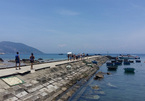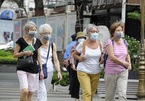 |
| Local tourists visit a tam giac mach (buckwheat) flower valley in the northern mountainous province of Ha Giang. VNA/VNS Photo |
The unpredictable developments of the COVID-19 pandemic are making it difficult for the domestic tourism sector to map out a path to recovery, as well as adaptation and growth. From your point of view, what should the industry focus on in the short and long terms?
The evolving pandemic in key tourism markets this year has severely affected the tourism industry. The closure and suspension of commercial flights as well as the 14-day quarantine protocol applicable to both departures and arrivals have reduced international travel by 80 to 90 per cent, according to World Tourism Organisation (UNWTO) statistics.
Like many other countries’ short-term strategies, Vietnam has focused on the domestic market.
Instead of stimulating demand with financial support, businesses need to invest in new products and improving service quality.
Another short-term solution is to make use of hotels located near major airports as paid quarantine sites, and to improve early airport testing capacity, as well as require on-site quarantine at designated accommodation facilities. This will create additional revenue for hotels while still ensuring quarantine protocol.
In the long term, in order to gradually reopen the industry, markets with good disease control such as Australia, New Zealand and Japan may be gradually licensed.
Specialised studies predict that the market will recover in three to five years.
New tourism trends will look to nature, avoid crowded urban areas and expand nature-based tourism in rural areas.
There will be changes in tourism demand with more expectations on quality.
The tourism industry needs to reposition markets and products, and instead of chasing visitor numbers, improve the average length of stay and spend.
This is a good opportunity to eliminate forms of international tourism that do not bring many benefits to localities, like the zero dong tours that have been reported in the media.
Digital transformation is an open direction, and is even considered as a base for the tourism industry at this time. What do you think about that?
This is an inevitable trend and the pandemic has accelerated digitisation.
On the principles of a shared economy and as information technology booms, traditional distribution channels will lose their advantage and be replaced by sharing platforms, such as Grab and AirBnb.
Reservation systems, information exchange and payment systems were digitised very quickly before the pandemic. Due to the impacts of COVID-19, companies and organisations in many places around the world have changed to remote working, exchanges, meetings and online learning.
After the pandemic, the cost-saving, time-saving, convenient and efficient advantages of working online will surely have a big impact on education and tourism.
The tourism sector needs to adapt to this trend. Digitalisation, in my opinion, will be effective in building information channels and strongly affect distribution channels, especially tourism industry personnel.
Secure payment platforms are also a problem the travel industry needs to tackle. However, the essence of tourism is experience and the integration of related services such as travel, accommodation and entertainment, so we cannot fully digitise tourism.
In addition, the nature of the service is the interaction between humans, and between humans and nature. Therefore, digitalisation is limited only to the complementary stage and should only act as an assistant. It cannot replace the main products.
However, digitalisation helps expand markets, save costs and empower customers with more choices. It means there will be more competitiveness, and digitalisation requires businesses to provide dynamic, modern and internationalised services.
Most tourism businesses are suffering due to the prolonged suspension, while tech solutions require time, manpower and financial investment. How should we deal with this problem?
According to market principles, difficulties and a changing environment are challenges for businesses. Those with potential, innovation and capital will survive.
The viability and transformation of businesses are their internal strengths, while stimulus packages and solutions are only short-term external agents. This is the time to change and test businesses so that those with real internal qualities will be able to adapt to the fierce market and survive.
State support, if any, should focus on social, non-profits and local entrepreneurs, as well as private business households. VNS/Nhan Dan

Domestic market to help tourism sector in post-COVID-19-period
The country's tourism industry saw impressive growth between 2015-19, but now needs a dramatic face-lift in terms of quality and safety to help the ‘key’ sector recover from COVID-19 damage.

Vietnam’s tourism industry loses $23 billion because of Covid-19
After a record-high growth rate in January, Vietnam’s tourism industry has fallen into a crisis caused by Covid-19.